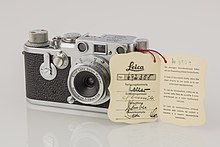Viewfinder camera

The viewfinder camera is a camera in which the lens is only used to expose the film . A separate lens, the viewfinder, is usually used to check the image section . However, many compact digital cameras are now available without an optical viewfinder; here the image converter in conjunction with a screen serves as a replacement for the viewfinder. Digital and 35mm viewfinder cameras without interchangeable lenses are also known as compact cameras . They dominate the market for cameras both in terms of numbers and sales. Viewfinder cameras are usually significantly cheaper than SLR cameras with a comparable recording format , but there are viewfinder cameras, especially those with interchangeable lenses, also in the upper price range.
functionality
The distance is set manually (often in combination with a built-in mixed image rangefinder as a so-called rangefinder camera ) and nowadays mostly automatically via an autofocus . Cameras in the lower price range have a wide-angle lens with a low light intensity and therefore do not have to adjust the focus ( fixed focus lens). In the past there were also viewfinder cameras with manual focus without a range finder; here one then had to estimate.
disadvantage
The viewfinder camera has a number of disadvantages compared to the single-lens reflex camera : The correspondence between the viewfinder image and the actually recorded section is not optimal, because parallax occurs particularly in the close-up range (see also parallax compensation ). It is not possible to check the depth of field in the viewfinder. An object in front of the lens , such as a finger, is not noticeable in the viewfinder. The use of interchangeable lenses is only possible with a few professional models and does not always mean that the viewfinder image adapts accordingly. When using telephoto lenses (from 90 mm) the corresponding picture frame in the viewfinder image is very small or a separate viewfinder is required. Focal lengths greater than 135 mm are therefore practically not offered for viewfinder cameras. With zoom lenses, the viewfinder should also have a zoom function, which is why almost exclusively interchangeable lenses with fixed focal lengths are offered.
These disadvantages can be eliminated with mirrorless system cameras with electronic viewfinder or hybrid viewfinder , such as the Fujifilm X-Pro2 . With these cameras, you can choose between an optical viewfinder based on the conventional principle, an electronic viewfinder that delivers the image from the image sensor, or an optical viewfinder with an integrated image of the electronic viewfinder (hybrid).
advantages
However, the disadvantages are offset by a number of advantages: viewfinder cameras are significantly lighter and smaller than SLR cameras . Since no mirror has to be folded down before taking the picture, it is much quieter and quieter. The brightness of the viewfinder image does not depend on the lens used.
Some lens or imaging constructions are only feasible for viewfinder cameras. With some lenses, the mirror of a SLR camera would literally stand in the way, large format and panorama cameras are all viewfinder cameras.
Voigtlander Vitomatic I Prontor (1957)
Rollei 35 S with flash
Rolleimatic viewfinder camera
Operation of the Rolleimatic
Miniature viewfinder camera Minox 35 ML with flash
Rollei 35S and Minox 35 ML viewfinder cameras











